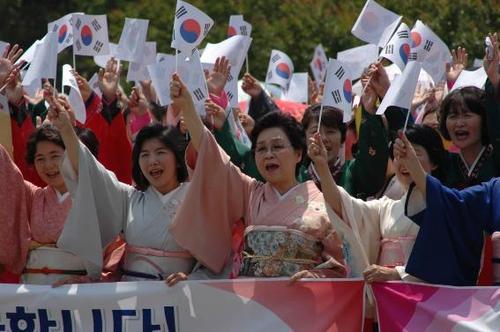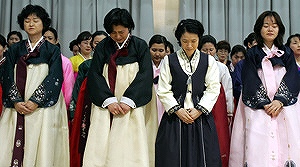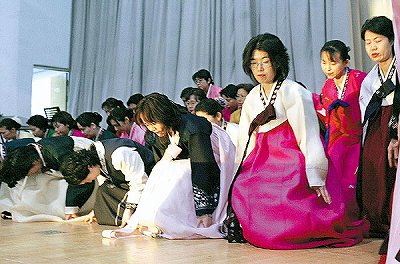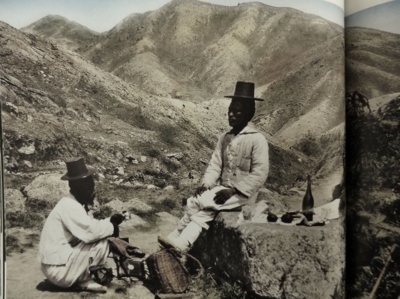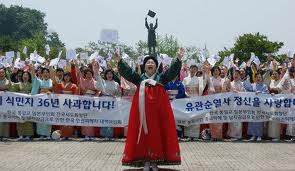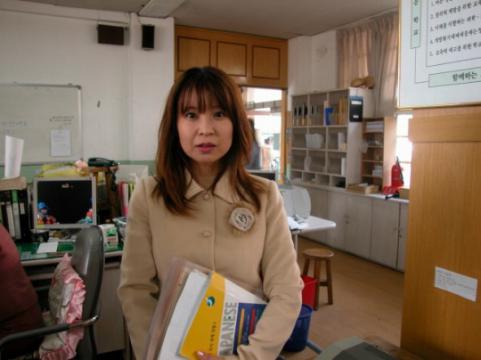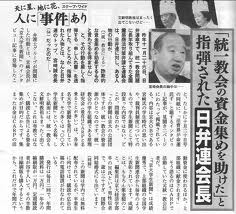http://koreaweb.ws/ks/ksr/ksr01-02.htm
Korean Studies
Internet Discussion List
KOREAN STUDIES REVIEW
Richard E. Kim, Lost Names: Scenes from a Korean Boyhood, Berkeley and Los Angeles:
University of California Press, 1998. 198 pages $12.95 (paper). ISBN: 0-520-21424-2.
Reviewed by
J. Michael Allen
Brigham Young University - Hawaii
Most readers of this review have probably already read Richard Kim's Lost Names. Those who have not should do so at the first opportunity. The reissue of Lost Names will be particularly welcome news to two groups: anyone interested in the experience of Koreans living under Japanese rule, and any teacher looking for a non-academic book on the colonial period to assign to students studying Korean history. It is an engaging book, both because of Kim's easy style and because of the youthful perspective from which the story is told. Richard Kim shuns questions of whether the book is fictional or autobiographical, pointing out that while he wrote it as fiction, it has generally been regarded as an account of his own early years. It is as a result of this "happy predicament" (in Kim's words) that the book has both the realism of remembered experience and the imagination of a series of stories. Kim has stated elsewhere that "everything in the book actually happened" to him. (SeeEducation About Asia, Vol. 4, No. 2 [Fall 1999], p. 23.) Nevertheless, he maintains that because he arranged and interpreted events while writing the book, it is not strictly autobiographical. More important than questions about the book's genre, however, is the fact that it puts a human face on the colonial period that can easily be overlooked in more academic treatments.
Each chapter is a separate story, which means that a teacher using this book would not necessarily have to assign the entire thing. Taken together, however, they form a vivid picture not only of life under colonial rule but of family dynamics as well. The incidents cover the period from 1933 (when the storyteller/author was one year old) to liberation in 1945. "Crossing" tells the story of the family's departure, across the frozen Tumen River, from Korea to Manchuria, where the father has taken a job at a Christian school shortly after his release from prison. The setting sun, "plummeting down toward the frozen expanse of the northern Manchurian plain," seems symbolic of the ultimate demise of the Japanese empire, even in the first story, twelve years prior to Japan's defeat.
The father's prison term is referred to a number of times throughout the book, and while it is never clear exactly what his offense was, the manner in which it is mentioned makes it clear that it had something to do with the authorities' perception that he was acting against them. It also becomes clear over the course of the book, however, that the narrator's father has earned the respect not only of his fellow Koreans, but of many Japanese colonial officials as well.
The family returns to Korea after a few years in Manchuria. The remaining chapters of the book chronicle school activities (including humiliation and intimidation at the hands of other pupils as well as teachers), various kinds of mobilization ordered by colonial authorities (from the collecting of rubber balls for recycling to the building of a runway), and the efforts of a family (one that clearly has considerable local prestige) to cope with unwelcome colonial rule while trying to avoid an oppressive siege mentality at home. The title story comes from the requirement that, as subjects of the Japanese emperor, Koreans adopt Japanese names. The day when the boy's father takes him to the local police station in order to register their new names is clearly a painful one for the family. The occasion becomes a chance for the father to teach his son a lesson about both national shame and personal dignity. After the registration is over and the family has been officially renamed Iwamoto, the father, with tears in his eyes, tells his son: "Take a good look at all of this. . . . Remember it. Don't ever forget this day."
Kim suggests the range of reactions to Japanese rule-from cooperation to resistance-that we know of from other sources. There is a mysterious uncle in Manchuria, clearly part of an anti-Japanese resistance movement. One of the boy's teachers, who rescued him from a beating overseen by a Japanese teacher, joins this uncle, only to be captured and killed as a spy in Mongolia by Russian forces. On the other end of the scale, there are Koreans like the detective who interrogates the boy's father at the beginning of the narrative, someone the boy's mother describes as the foreigners' hound. But equally important (and perhaps more representative) are all the Koreans found between these two extremes. These Koreans are not as visibly represented in Kim's volume, but one always knows they are there. Similarly, Kim does not want to depict Japanese as easily pigeonholed, cardboard characters-even those who officially represent the Japanese state that has subjected Korea. He issues no blanket condemnations of Japan or Japanese. The group whose motivation and actions he wishes to analyze most is his own countrymen. In the 1999 interview referred to earlier, Kim declared that one of his missions in life was "to teach Koreans to accept responsibility for their lives, to stop blaming others, the Japanese, the Chinese. We lost it. . . . but many Koreans would like to think someone grabbed it . . . thinking this justifies hatred. I've often said that Koreans need a national psychotherapy session, a large couch. Why are we as we are, why is self-examination such a rare commodity in Korean life?" (Education About Asia, p. 25.) A "national psychotherapy session"? This is quite a call. But such a frank statement, it seems to me, suggests that Kim himself has done rather a lot of thinking about responsibility and history, and about just what else may have been "lost" along with Korean names.
The final chapter, "In the Making of History-Together," is powerfully evocative of the ambiguity both of liberation and of the liberated. The boy and his father have a conversation about what liberation means for them and for all of Korea. The boy has previously told his mother of his feelings of shame that liberation was not won by Koreans, but given to them. "It just dropped from the sky," he had complained. "Just like that. A present!" His father, who knows of this conversation, tries to explain not only what liberation means, but what he sees as the burden of successive generations of Koreans. "You are right. Our liberation is a gift, so to speak, and not something that we have fought for and won. That bothers me, too, son. And perhaps that's why most of us, the grown-ups, are confused and bewildered and feel at a loss." He then explains that his own father's generation was "ineffective and disorganized-not only aimless but also very stupid in many ways, although the royal dynasty had more to be blamed for than anyone else in the country. They let the country get kicked around and, finally, sold down the river, you might say. Then, they handed it over to my generation and said, 'Look, we are sorry about this, but there wasn't anything we could do to save the country.' Now, what could my generation do?" The generation that led Korea in 1910 could have prevented the loss of the country, the father argues, and could have put in place many needed reforms, but as Japanese rule became more and more entrenched after annexation, it was too late. For this generation, the burden was survival: "We could do very little, too, except, perhaps . . . to sustain our faith and remain strong in spirit, hoping, just hoping, that, someday, a day like today would come. Survival, yes, that's it. Survival. Stay alive. Raise families, our children, like you, for the future. Survival, son, that's what my generation accomplished, if that can be called an accomplishment."
But the torch also passes from the father's generation to the son's. Recognizing this, the father expresses his hope for the future: "I am only hoping that your generation will have enough will and strength to make sure the country will not make the same mistakes and repeat its shameful history. I only hope, son, that mere survival will not become the only goal of your generation's lives. There must be more in life than just that." This exchange epitomizes both the anguish behind the history of Korea's liberation, and the multiple possibilities for the future that liberation held. The post-liberation generation, as the concluding chapter's title suggests, must become masters of their future, making history rather than merely watching it happen, becoming the shapers of their destinies rather than pawns in others' power schemes. The book ends on that note, and on an optimistic determination on the part of the narrator to ensure that the future of Korea does indeed belong to Koreans.
Since its first publication in 1970, Lost Names has attracted a loyal following among teachers and students of Korea. This reissue will make it even more accessible. Perhaps it will also lead some readers in the direction of Kim's other books on Korea (The Martyred [1964]; The Innocent[1968]), helping to ensure that an eloquent voice continues to be heard.
Citation:
Allen, J. Michael 2001
Review of Richard E. Kim, Lost Names: Scenes from a Korean Boyhood (2000)
Korean Studies Review 2001, no. 2
Electronic file: http://koreaweb.ws/ks/ksr/ksr01-02.htm
http://koreaweb.ws/ks/ksr/ksrndx.htm
http://koreaweb.ws/ks/ksr/ksr02-07.htm
Korean Studies Internet Discussion List
KOREAN STUDIES REVIEW
John B. Duncan. The Origins of the Chosôn Dynasty. Seattle: University of Washington Press, 2000. 395 pages. ISBN 0-2959-7985-2.
Reviewed by J. Michael Allen
Brigham Young University - Hawaii
[This review first appeared in Acta Koreana, 5.1 (2002): 97-99. Acta Koreana is published by Academia Koreana of Keimyung University.]
Perhaps partly because we live in an age in which dynasties do not dominate the political landscape, a change in dynasty seems like it should be a momentous event with wide-ranging effects. Indeed, so seductive is the dynastic-change paradigm that we still tend to divide up long histories into dynasty-sized chunks. Such divisions compartmentalize history into what appear to be more manageable portions. One of the effects of such compartmentalization is to emphasize discontinuities and apparent new starts, often at the expense of comparable attention to structures, ideas, and institutions that are resistant to changes in the surname of the ruling family.
It need not only be dynasties that have the powerful effect of attracting to themselves credit for fundamental changes that either did not happen at all, or happened over a much longer period of time than a simple change of government can account for. I remember as a graduate student being intrigued by Princeton historian (now emeritus) Arno Mayer's book The Persistence of the Old Regime: Europe to the Great War (New York: Pantheon, 1981). Mayer argued that the origins of World War I lay in the desire of Europe's old aristocrats and those aspiring to such status to maintain their position. He directly challenged the view that Europe's old aristocracy was a museum piece in the first two decades of the twentieth century, stripped of effective influence in favor of the bourgeoisie, the group assumed to have emerged by this time as the real actors in the European historical drama.
It was Mayer's work, rather than other studies of Korean history, that first came to mind when I took up John Duncan's important new book. Duncan argues persuasively that the fourteenth-century change from Koryô to Chosôn was not the wholesale replacement of an old aristocracy by a new group with new interests. Rather, he examines the Koryô-Chosôn transition in the context of centuries-long developments in governing structures going back at least to the beginning of the Koryô kingdom in the tenth century. It was the structures put in place in the early Koryô period that led to the development of the yangban aristocracy-a group whose interests were not only opposed to those of the hyangni local elite (from whose ranks many of the yangban originally sprang), but were increasingly at odds with royal authority as well. In this situation, the forces of reform represented by the powerful and ambitious Yi Sônggye were a magnet for the yangban not because the latter were revolutionaries, but because they hoped to protect the privileges to which their class had become accustomed.
Duncan argues that the institutions of Koryô rule were designed to accommodate the needs of the locally based hyangni, and to recognize the government's need for their cooperation in the absence of a tradition of strong central rule. The coalescing of the yangban as a new, centralized, bureaucratic elite changed everything, however. By the late fourteenth century, according to the author, "what was needed was a radical reshaping of the dynasty's institutions to reflect the reality of the central yangban's emergence as the dominant social group" (202). In other words, Duncan does not argue that there were no important sociopolitical changes across the Koryô-Chosôn expanse. The most important ones, however, occurred not at the time of, or following, the dynastic transition itself, but much earlier, as the institutions of power took shape after the founding of Koryô. It was only in the late fourteenth century, however, that serious thought was given to reshaping the state's institutional structure to reflect sociopolitical realities that had changed long before. As Duncan puts it, "a major feature of the Koryô-Chosôn transition was the continued domination of the central bureaucracy by the great yangban descent groups of the Koryô, making it very unlikely that revamped institutions represented the concerns of a new social class" (204). In other words, as the title of Mayer's book suggested, the founding of Chosôn represents in important ways the persistence of the old regime.
Chapter 1 of Duncan's history, "The Koryô Political System," draws on the work of S. N. Eisenstadt, among others, to describe the early Koryô political system and its limitations. Koryô's kings are shown to have been severely compromised in terms of their ability to wield the power of a centralizing state. The primary check on royal authority was a new hereditary group of land-owning high officials who dominated politics at the center. This group is described in more detail in Chapter 2, "Central Bureaucratic Aristocracy." Though the new bureaucratic aristocracy had its roots and its wealth in land outside the capital, over the course of the Koryô period their interests and identity lay more and more in the capital, and they increasingly defined themselves in terms of a history of office-holding rather than by reference to their earlier status as members of more localized elites. By the late Koryô period, this group's sense of itself had taken on the characteristics normally used to describe the yangban of the Chosôn period. "The use of the term yangban by late Koryô elites to refer to themselves as a discrete social entity appears to be a natural consequence of the great official descent groups' awareness that the source of their prestige lay in their history as central office-holders" (88-89). In Chapter 3, "The Yangban in the Change of Dynasties," Duncan examines in detail the continuities in the elites of the Koryô and Chosôn periods. This chapter is full of statistical analysis and contains the majority of the book's twenty-six tables illustrating the connections between descent and central office holding.
Chapter 4, "Institutional Crisis in the Late Koryô," discusses developments in the second half of the Koryô period that are crucial for understanding the author's contention about the timing and nature of the sociopolitical changes preceding the fourteenth-century dynastic transition. Just at the time when royal power was severely compromised due to military and Mongol domination, the yangban moved into a stronger position in the central bureaucracy. The problem for these yangban was that the Koryô political system was designed to meet the needs of local elites who had become accustomed to exercising influence and controlling resources in a state that was not strongly centralized. As described in Chapter 5, "Reform and Dynastic Change," it was largely in order to resolve these contradictions that the central yangban supported early Chosôn reforms. This led to important areas of royal-yangban common interest, particularly in reforms designed to reduce the power of local elites. In Chapter 6, "The Ideology of Reform," Duncan takes up the question of the role of "a new and vigorous Confucian discourse," based on Chinese Ch'eng-Chu Learning (he shuns the term "Neo-Confucianism) in the Koryô-Chosôn transition. Having already made the case that there was no new group of scholar-officials that rose to prominence only with the advent of the new dynasty, he now challenges the view that Ch'eng-Chu Learning was the "class ideology" of any such group. This is not to say that Ch'eng-Chu Learning was unimportant in the early Chosôn period, or that it was used only cynically to buttress a new dynasty. Interest in a revitalized Confucianism dates to the time of the Mongol Yuan dynasty and its influence on Koryô, but it always had to find accommodation with a Korean "Ancient Style" intellectual tradition. Indeed, the set of ideas that Duncan sees motivating and justifying political reform in the first half of the Chosôn period is a hybrid of Ancient Style and Ch'eng-Chu. This appears to be another case in which the obvious (a dynastic transition) obscures the less obvious but perhaps more important (a mixing of intellectual traditions providing an ideological basis for reform).
In the concluding chapter Duncan steps back from the details to discuss how his findings relate to broader questions in Korean Studies and points to some themes of interest to those whose specialties lie outside of Korea. Here and throughout the book, Duncan very usefully compares his conclusions about Korean sociopolitical arrangements with what is known about China. He uses an impressive array of Korean primary sources as the foundation for his argument, which he augments with wide reading in relevant secondary material in Korean, Chinese, Japanese, and English.
The latest volume in the Korean Studies monograph series from the University of Washington's Jackson School of International Studies, under the general editorship of James B. Palais, this convincing and important contribution to our understanding of Korean history should also be of great value to scholars interested in comparative studies of social structures and political power.
Citation:
Allen, J. Michael 2002
Review of The Origins of the Chosôn Dynasty, by John Duncan (2000)
Korean Studies Review 2002, no. 7
Electronic file: http://koreaweb.ws/ks/ksr/ksr02-07.htm
http://www.steptoe.com/professionals-596.html
Alternate Office
1114 Avenue of the Americas
New York, NY 10036
TEL: 212.378.7578
FAX: 212.506.3950
Areas of Practice
Litigation
IP Litigation
Patent Litigation
Trademark Litigation
Section 337/ITC Litigation
Intellectual Property
Trademark
Trade Secrets
Copyright
Entertainment
Media Law
Education
Syracuse University College of Law, J.D., cum laude, 1998, Syracuse Law Review, Syracuse Moot Court Board
Hamilton College, B.A., 1995
Bar & Court Admissions
District of Columbia
New York
South Carolina
US Courts of Appeals for the Federal Circuit and the Second Circuit
US District Court, District of Columbia
US District Court, Southern and Northern Districts of New York
Michael J. Allan
Partner
mallan@steptoe.com
vCard
Washington Office
1330 Connecticut Avenue, NW
Washington DC 20036
TEL: 202.429.6749
FAX: 202.429.3902
Michael J. Allan is a partner in the Washington and New York offices of Steptoe, where he is a member of the Intellectual Property and Litigation groups.
Mr. Allan’s practice involves the prosecution and defense of trademark, trade secret, copyright, unfair competition, false advertising and patent claims. He has successfully litigated numerous intellectual property and other complex commercial litigation cases on behalf of his clients in the manufacturing, pharmaceutical, entertainment, and financial services industries. He has appeared in federal district and appellate courts throughout the country, as well as in administrative proceedings at the International Trade Commission and the Trademark Trial and Appeal Board.
Mr. Allan’s recent victories include a June 2010 Federal Circuit Court of Appeals victory in which Mr. Allan obtained a complete reversal of a significant sanction award pursuant to 28 U.S.C. § 1927 on behalf of a New York City based law firm. In January, Mr. Allan obtained a summary judgment of $4 million for a British fashion house in a trademark infringement and breach of contract case. In October 2008, Mr. Allan secured $3.5 million judgment on behalf of a major French fashion house. In January 2008, Mr. Allan completed a successful trial in the Middle District of Alabama against Region University for infringement of the Regions mark of Regions Bank.
In addition, Mr. Allan is actively involved in counseling clients on intellectual property rights and enforcement strategies. Specifically, he has drafted and negotiated intellectual property agreements as well as counseled clients on due diligence reviews and intellectual property licensing and transfer agreements.
Mr. Allan also has extensive litigation and trial experience in a variety of disciplines and industries.
Representative Matters
A representative list of Mr. Allan's matters appear below:
Serves as lead counsel to several luxury brands on intellectual property enforcement and unfair competition matters;
Lead counsel to a large manufacturing company in a copyright infringement lawsuit;
Lead counsel to an Internet services company in a complex trade secret litigation;
Represents a major financial institution in connection with trademark, unfair competition and false advertising matters;
Represents a French pharmaceutical company in Hatch-Waxman patent litigation and related antitrust litigation;
Enforced a non-competition agreement against a former software executive;
Represented a major tobacco company in several trademark counterfeiting and infringement lawsuits;
Represented a large automobile insurance carrier in several trademark infringement and product disparagement cases nationwide;
Defended a US pharmaceutical company against alleged advertising violations by several state Attorneys General;
Defended a major US pharmaceutical company in a nationwide products liability class action lawsuit; and
Represented a niche pharmaceutical company in an international arbitration with US and Indian companies over a development and supply agreement dispute.
Select News & Events
AIPLA Annual Meeting, October 26, 2012
International AntiCounterfeiting Coalition (IACC) 2012 Fall Conference, October 18, 2012
Anti-Counterfeiting & Brand Protection Summit, September 21, 2012
Law360 Quotes Michael Allan on Second Circuit’s Louboutin Decision
Corporate Counsel Cites Steptoe’s Allan on Trademark Application Policy in Beyoncé Rocket Docket
The Crowdfunding Conference, April 19, 2012
Steptoe Announces Promotion of 13 Lawyers
Steptoe Prevails at Seventh Circuit in Bankruptcy Case
"The Intersection Between Civil Enforcement and Criminal Prosecution," INTA Annual Meeting, May 10, 2011
Law360 Quotes Michael Allan on Counterfeiting
Appellate Victory at the Federal Circuit
Trade Secrets: New Trends and Best Practices, May 6, 2010, (A Steptoe-Sponsored Event)
Selected Publications
The Red Sole Survives – A Modified Louboutin Mark is Upheld By The Second Circuit
September 6, 2012
Rogue Websites and the ITC: New Proposed Anti-Piracy Legislation
December 16, 2011
Cybersquatting Update: New Protections for Brand Owners
March 17, 2011
Intellectual Property Advisory - Does eBay Need a Disclaimer? Tiffany v. eBay, The Second Circuit Rules
April 5, 2010
http://www.history.northwestern.edu/people/documents/cvAllen.pdf
Michael J. Allen
Northwestern UniversityDepartment of History1881 Sheridan RoadEvanston, IL 60208m-allen1@northwestern.edu
EMPLOYMENT
NORTHWESTERN UNIVERSITY, Evanston, IL Associate Professor of 20th-century US history, 2011-Assistant Professor of 20th-century US history, 2008-11
NORTH CAROLINA STATE UNIVERSITY, Raleigh, NC Assistant Professor of 20th-century US history, 2003-08
EDUCATION
NORTHWESTERN UNIVERSITY, Evanston, IL
Degrees: Ph.D., 2003; M.A., 1998
Dissertation: "The War's Not Over Until the Last Man Comes Home": Body Recovery And The Vietnam War
Dissertation Committee: Michael Sherry (chair), Nancy MacLean, Laura Hein
Master's Thesis: "Seeketh That Which is Gone Astray": Finding the Meaning of Prisoner of War Defection Following the Korean War
THE UNIVERSITY OF CHICAGO, Chicago, IL
Degree: B.A. in History with honors, 1996
Honors Thesis: From Normal to Neurotic: Psychoneurotic World War II Veterans and the Roots of Postwar Anxiety
PUBLICATIONS
BOOKSThe Confidence of Crisis: Confronting the Imperial Presidency, 1968-1992, book project in progress.
Until the Last Man Comes Home: POWs, MIAs, and the Unending Vietnam War, University of North Carolina Press, 2009.
RESEARCH ARTICLES
"'The Least We Can Do': Child Rescue and National Redress at the End of the Vietnam War," article manuscript in progress.
"'Help Us Tell the Truth About Vietnam': POW/MIA Politics and the End of the American War," in Making Sense of the Vietnam Wars: Local, National, and Transnational Perspectives, edited by Mark Philip Bradley and Marilyn B. Young, 251-75, Oxford University Press, 2008.
REVIEW ARTICLES Review of Foreign Relations of the United States: 1969-1976, Volume VII: Vietnam, July 1970-January 1972, in Passport, forthcoming January 2013.
"The Limits and Fears of Flesh and Blood," Reviews in American History, Vol. 37, no. 3 (Sept. 2010): 539-47.
Author's Response to reviews of Michael J. Allen, Until The Last Man Comes Home: POWs, MIAs, and the Unending Vietnam War, in H-Diplo Roundtable Reviews, Vol. 11, no. 50 (Sept. 2010): 24-30.
Review of Edwin Martini, Invisible Enemies: The American War on Vietnam, 1975-2000, in H-Diplo Roundtable Reviews, Vol. 9, no. 12 (June 2008): 6-12.
SHORT REVIEWS AND OTHER WRITING Introduction to H-Diplo Roundtable for Meredith Lair, Armed With Abundance: Consumerism and Soldiering in the Vietnam War for H-Diplo Roundtable Reviews, forthcoming 2012.
Review of Jerry Lembcke, Hanoi Jane: War, Sex, & Fantasies of Betrayal for Pacific Historical Review, Vol. 81, no. 1 (February 2012): 145-46.
Review of Scott Laderman, Tours of Vietnam: War, Travel Guides, and Memory, for Journal of American History, Vol. 96, no. 4 (March 2010): 1248-49.
"The Disposition of the War Dead," 2,000-word entry for Encyclopedia of Military Science, Sage Publications, forthcoming 2012.
"Neutral Nations Repatriation Commission," Encyclopedia of Prisoners of War and Internment, Jonathan
F. Vance, ed., ABC-CLIO, 2000, 204-05.
"Liberation," co-authored with Jonathan F. Vance, Encyclopedia of Prisoners of War and Internment, Jonathan F. Vance, ed., ABC-CLIO, 2000, 169-73.
"'Stolen Honor' Skews Its View of Vietnam," Raleigh News & Observer, October 27, 2004, 19A.
HONORS, FELLOWSHIPS, AWARDS
PROFESSIONAL Friends of the Princeton University Library Research Grant, 2011 Gerald R. Ford Foundation Research Grant, 2010 CHASS Scholarly Project Award, North Carolina State University, 2006
Allen curriculum vitae, 2012
GRADUATE Dissertation Year Fellowship, Northwestern University, 2002-03 Kaplan Center for the Humanities Graduate Teaching Fellow, Northwestern University, 2001-02 The Dirksen Congressional Center Research Award, 2001 Gerald R. Ford Foundation Research Grant, 2000 Graduate Research Grant, Northwestern University, 2000
UNDERGRADUATE General Honors in The College, The University of Chicago, 1996 Honors in the History Concentration, The University of Chicago, 1996 Richter Grant for Summer Research, The University of Chicago, 1996 Marshall Wais Scholarship, The University of Chicago, 1994-95
PRESENTATIONS
PAPERS
"The Imperial Presidency and Its Critics: The Domestic Politics of American Empire," Society for Historians of American Foreign Relations Annual Meeting, Storrs, CT (forthcoming 2012)
"The Rise and Fall of Congressional Antiwar Activism," Organization of American Historians Annual Meeting, Milwaukee, WI (forthcoming 2012)
"'The Least We Can Do': Child Abandonment and Rescue at the End of the Vietnam War," American Studies Association Annual Meeting, San Antonio, TX, 2010
"The Missing, In Action: Accounting for the Missing Dead in U.S.-Vietnam Relations, 1973-2001," Keynote Address, Interdisciplinary Graduate Student Conference on Peace and War, Institute for the Humanities, University of Illinois at Chicago, Chicago, IL, 2010
"The Missing, In Action: Accounting for the Missing Dead in U.S.-Vietnam Relations, 1973-2001," Buffett Center for International and Comparative Studies, Northwestern University, Evanston, IL, 2009
"Fostering Interdisciplinary Learning and Teaching Across the University: A Top-Down Approach for a Bottom-Up Solution," Council on Undergraduate Education Interdisciplinarity in General Education Symposium, North Carolina State University, Raleigh, NC, 2008
"The Domestication of War," American Historical Association Annual Meeting, Washington, DC, 2008
"'Help Us Tell the Truth about Vietnam': POW/MIA Politics and the End of the American War," Making Sense of the Vietnam Wars Conference, University of Kentucky, Lexington KY, 2007
"Artifacts of Loss: Lost Bodies and Lost Wars in American Mourning," American Studies Association Annual Meeting, Washington, DC, 2005
"Flip-Flop: John Kerry And Public Memory Of The Vietnam War," Society for Historians of American Foreign Relations Annual Meeting, College Park, MD, 2005
"'Once We Met As Adversaries; Today We Work As Partners': Body Recovery in U.S.-Vietnam Relations, 1973-2000," Organization of American Historians Annual Meeting, San Jose, CA, 2005
"The Never-Ending Search: The Memorial Politics of Body Recovery After the Vietnam War," American Historical Association Annual Meeting, Washington, DC, 2004
"Leave No Man Behind: Body Recovery as Casualty Aversion After the Vietnam War," Triangle Institute for Security Studies New Faces Conference, Duke University, Durham, NC, 2003
"Naming the Unknown: The Privatization of Memory After the Vietnam War," Society of Military History Annual Meeting, Madison, WI, 2002
"'The Problem Defies Satisfactory Solution': Seeking the Meaning of Korean War POW Defections," History: Military and Society VI conference, Ohio State University, Columbus, OH, 1999
"'The Problem Defies Satisfactory Solution': Korean War POWs as Symbols of Cold War America," Popular Culture Association Annual Meeting, San Diego, CA, 1999
COMMENTS AND CHAIRS
Chair for panel "Aftermath of War: The Politicization of Family, Society, and Soldiers' Experiences During and After the Korean War," Society for Historians of American Foreign Relations Annual Meeting, Alexandria, VA, 2011
Comment for panel "Obligation and Coercion in Twentieth Century America: Gender and the Wartime State," Society for Military History Annual Meeting, Lisle, IL, 2011
Comment for paper "American Expatriates and the WRI Campaign Against the Vietnam War" by Joshua D. Cochran, New Approaches to America and the World, University of Chicago-Northwestern University Graduate Student Conference, Chicago, IL, 2011
Comment for panel "Kennedy's Headaches," Society for Historians of American Foreign Relations Annual Meeting, Madison, WI, 2010
Comment for panel "Causes and Effects; Representing Soldiering in the Era of the All-Volunteer Military," Society for Military History Annual Meeting, Lexington, VA, 2010
Comment for panel "Moxie and Might in a Changing Military," Fourth Annual North Carolina Graduate Student History Conference, Raleigh, NC, 2008
Co-comment for panel "Horses and Horse Power: Sports Culture Through History," Third Annual North Carolina Graduate Student History Conference, Raleigh, NC, 2007
Comment for paper "Overcoming the Division: The Korean War Monument and the Politics of Peace" by Sheila Miyoshi Jager, Triangle East Asia Colloquium, Durham, NC, 2006
Comment for panel "Food and Film: Popular Culture in Twentieth Century America," First Annual North Carolina Graduate Student History Conference, Raleigh, NC, 2005
INFORMAL TALKS AND INTERVIEWS "What's the Matter with Congress," Casino Club Monday Lecture Series, Chicago, IL, 2011
"Inside, Outside, Upside Down: Researching the Politics of War," Alumnae of Northwestern University Continuing Education Program, Evanston, IL, 2011
"Go Public: A Glimpse Into The Complexities of POW/MIA Politics," Wisconsin Veterans Museum, Madison, WI, 2009
Discussant for TimeLine Theater's production of Arthur Miller's All My Sons, Sunday Scholars Series, 2009
"Back to the Beginning: U.S.-Vietnam Relations Since 1973," Vietnamese Interacting as One conference (VIA-1), Northwestern University, Evanston, IL, 2009
"Prisoners of the Vietnam War: Who They Were, Why We Cared," Raleigh Public Library series on The Sixties, Raleigh, NC, 2006
"Bringing the Bodies Home," Chronicle of Higher Education, 17 May 2002, B4.
Interviews on WILL AM580; WUSB 90.1FM; KERA 90.1FM; POW/MIA radio; Talking History internet radio.
Informal presentations to New Trier High School (2011); Sigma Chi Fraternity (2011); Willard
Residential College (2011); Public Affairs Residential College (2011, 2010); Slivka Residential
College (2010).
Member of Society for Historians of American Foreign Relations Nominating Committee, 2011-Member of the Richard W. Leopold Lectureship Committee, 2011-Member of the Advisory Council for the Nicholas D. Chabraja Center for Historical Studies, 2011-Member of Society for Historians of American Foreign Relations Graduate Student and Grants
Committee, 2009-Co-Organizer of Global America, a year-long collaboration between Northwestern University and the University of Chicago on new approaches to America and the world, 2010-11 Referee for the National Endowment for the Humanities Division of Preservation and Access Humanities Collections and Reference Resources Grants, 2010 Consultant to Chicago Public Radio production "After the Wars: Stories and Images of America's Veterans," 2010 Co-Organizer of the Triangle History of the Military, War, and Society Seminar Series, co-sponsored by Duke University, University of North Carolina at Chapel Hill, and North Carolina State University, Durham, NC, 2006-08 Manuscript reviewer for University of Wisconsin Press and Pacific Historical Review
TEACHING AND ADVISING
COURSES
American Studies 301-2: "Global 1968 and Its Afterlives," Undergraduate seminar, Northwestern University (Winter 2012)
History 102-6-22: "Consumerism and Social Change in 'Mad Men' America, 1960-63," Freshman seminar, Northwestern University (Fall 2010)
History 102-6-22: "Ronald Reagan and the Rise of the Political Right," Freshman seminar, Northwestern University (Winter 2009)
History 210-2: "History of the United States: Reconstruction to the Present," Undergraduate lecture, Northwestern University (Spring 2012, Winter 2011)
History 252: "Modern American History," Undergraduate lecture, North Carolina State University (Summer 2008, Spring 2008, Fall 2006, Spring 2006, Fall 2005, Summer 2005, Spring 2005, Fall 2004, Spring 2004, Fall 2003)
History 300-01/02: "Sophomore Seminar on Historical Research and Writing," Undergraduate seminar, North Carolina State University (Fall 2007)
History 315-3: "The United States: Late 20th-century to Present," Undergraduate lecture, Northwestern University (Winter 2011, Winter 2010)
History 321-0: "The Vietnam Wars," Undergraduate lecture, Northwestern University (Winter 2012, Spring 2010)
History 391-0-23: "Lectures in History: The Vietnam Wars," Undergraduate lecture, Northwestern University (Winter 2009)
History 392-26: "Ronald Reagan and the Rewriting of American History," Undergraduate seminar, Northwestern University (Summer 2002)
History 392/395: "The War Dead in American Life," Undergraduate topical seminar/undergraduate research seminar, Northwestern University, (Fall 2010)
History 395-29: "The Sixties as History," Undergraduate research seminar, Northwestern University (Winter 2000)
History 410-3: "General Field Seminar: Twentieth-Century United States," Graduate seminar, Northwestern University (Spring 2012, Fall 2008)
History 451/551: "The Vietnam Wars," Undergraduate and graduate seminar, North Carolina State University (Fall 2006, Spring 2006)
History 452/552: "Recent America," Undergraduate and graduate seminar, North Carolina State University (Fall 2007, Fall 2005, Fall 2004, Fall 2003)
History 491C/599: "The Vietnam Wars," Undergraduate and graduate seminar, North Carolina State University (Spring 2005, Spring 2004)
History 492-23: "Cultural Encounters of American Empire," Graduate seminar, Northwestern University (Winter 2010)
History 563: "History and Memory," Graduate seminar, North Carolina State University (Spring 2008)
Humanities 391-1,2,3: "Media on the American Landscape," Undergraduate interdisciplinary seminar and lecture series, Northwestern University (Fall 2001-Spring 2002)
CURRICULUM DEVELOPMENT History 321-0: "The Vietnam Wars," Northwestern University, created 2009 History 563: "History and Memory," North Carolina State University, created 2006 History 451/551: "The Vietnam War," North Carolina State University, created 2006
ADVISEES AND INDEPENDENT STUDIES Nora Gannon, American Studies 390, Northwestern University, 2011-Zachary Ratner, American Studies 390, Northwestern University, 2011-Matt June, History 570/580, Northwestern University, 2010-Ashley Johnson, History 570/580/ABD, Northwestern University, 2009-Wen-Qing Ngoei, History 570/580/ABD, Northwestern University, 2009-Rory O'Byrne, WCAS Summer Research Grant, Northwestern University, 2011 Nathan Enfield, Leopold Fellow, Northwestern University 2011-Sarah Schutt, Leopold Fellow, Northwestern University, 2010-11 Craig Spencer, Leopold Fellow, Northwestern University, 2009-10 Jillian Foley, History 398-1,2,3, Northwestern University, 2009-10 Andrew Bank, Undergraduate Summer Research Grant, Northwestern University, 2009
DISSERTATION COMMITTEES Alex Hobson, Northwestern University, 2011-Laila Ballout, Northwestern University, 2011-Takaaki Daitoku, Northwestern University, 2010-Theresa Keeley, Northwestern University, 2010-Rebecca Marchiel, Northwestern University, 2010-Zachary Jacobson, Northwestern University, 2009-Andrew Warne, Northwestern University, 2008
OTHER ADVISING Afternoon Advising, Northwestern University, 2008-11 PARC Residential Fellow, Northwestern University, 2009-History Club Adviser, North Carolina State University, 2004-06 American Historical Association Organization of American Historians Society for Historians of American Foreign Relations American Studies Association Society for Military History
Assistant editor, Northwestern University Press (2000)Archival internship, Chicago Historical Society (1995)Archival internship, Dwight D. Eisenhower Presidential Library (1994)











